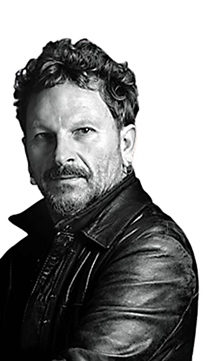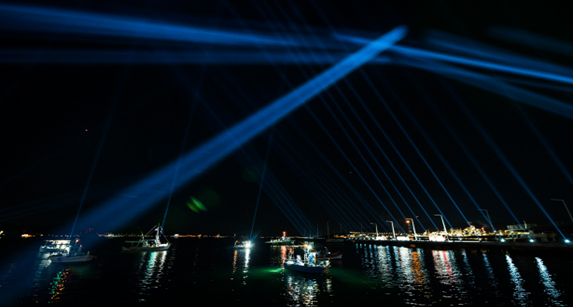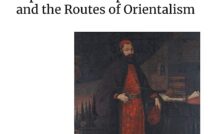

This is part of a Roundtable on The European Capitals of Europe.
Elefsina (“Elefsis” in ancient Greek and also called “Eleusis” today) is a 2023 European Capital of Culture (ECoC). It is a small city of 27,000 inhabitants in the western outskirts of Athens, in the Thriassian Plane—a region with 4,000 years of history. It is one of the five sacred cities of ancient Greece. It is where the Elefsinian Mysteries, the secret initiation rites in the cult of Demeter and Persephone, were held; and it is also the birthplace of Aeschylus, an ancient poet of dramaturgy. In the late nineteenth century, it started developing into one of the most dynamic industrial areas in Greece. However, during the last decades of the twentieth century, it suffered from de-industrialization and environmental degradation. Therefore, leaders have chosen culture as an engine for the future holistic development of the city. The European Capital of Culture (ECoC) Action is a promising step forward for the city as it enters the post-industrial era. Michail Marmarinos took office as the Artistic Director of 2023Eleusis in the midst of the city’s preparation for the ECoC project. He also conceived the 2023Eleusis inaugural ceremony that took place in February (Figure 1). He speaks to us about his experience.
—Anastasia Paparis for EuropeNow

EuropeNow What were the main assets of Elefsina in the competition for the 2023 title of ECoC? In what way does the city specifically fulfill the main goals of the ECoC program in terms of building Europeanness?
Michail Marmarinos Elefsina responds to the main goals of the ECoC Action in various ways based on its history and current situation. The European Union aims at showcasing the material and non-material economic resources of European cities through culture, the arts, and research. In the past few years, the “Action” has been directed to smaller but dynamic cities that have specific characteristics. For instance, Elefsina is a 4,000-year-old city that has never been conquered, as it used the myth of the “Elefsinian mysteries” to resist potential conquerors such as Athenians and Romans.
“Civilization” is believed to originate in the abandonment of nomadic lifestyles and the permanent settlement of the population in areas with fertile land. In Elefsina, agricultural production and land cultivation started in the Neolithic Era, allowing for the emergence of the myth of Demeter and Persephone, two important deities in ancient Greece. In Greek mythology, Pluto kidnapped Persephone, Demeter’s daughter, and led her to the Underworld, where she had to spend six months every year. She spent the rest of the year on the ground above, with her mother Demeter. The myth represents the annual cycle of nature’s fertility and production. It has remained alive to this day, constituting the inner dynamics of the Elefsina, as the myth is still present in the city’s sub-strata and the collective subconscious of its inhabitants. The myth has been celebrated through the “Elefsinian Mysteries,” which are annual rituals dedicated to Demeter and Persephone. Through the loss and recovery of Persephone, the existence of the Underworld (Άδης in Greek) and the conscious cycle of re-incarnation were institutionalized in the Ancient Greek world. The celebration of the Elefsinian Mysteries has allowed the city to remain continuously engaged with philosophical questions about the afterlife and address the stress associated with death—what has been called “death stress.” In the nineteenth century, the Elefsinian Mysteries continued to motivate visitors to come to the city. Therefore, we have many paintings of Elefsina from that period. Those visitors have been searching for “something” that was always hidden. Indeed, the details of the ceremonies (the so-called “mysteries”) were not made public in Ancient Greece, and the same was true of the relationship between life, death, and the afterlife.
Elefsina is also the birthplace of Aeschylus, a great poet of dramaturgy in ancient Greece. Great intellectual emperors such as Hadrian, Marcus Aurelius, and Antoninos were familiar with the Elefsinian Mysteries and the city’s sanctuaries. During that period, Roman emperors built significant monuments as offerings to the gods, and the city’s influence in the ancient world lasted until 396 AD, at which time the city was destroyed by Alaricus, King of the Visigoths, and by Christians, who found the idea of the “afterlife” problematic.
In the modern era, the position of the city on the coast and the fact that it possessed significant amounts of raw materials—such as resins and olives—led to industrial development, and the city became the country’s main industrial center. However, this development did not always occur in a linear way, as it was often plagued with conflicts. Therefore, city leaders and inhabitants started to interrogate themselves about how the city could reorganize itself to secure its future. The ECoC Action comes into play in response to this interrogation. As it transitions to a post-industrial state, which among its attributes can Elefsina develop? First, Elefsina is an important site for domestic migration flows. Indeed, the city has always welcomed people from various parts of the country. These people, along with Greek Arvanites (people of Albanian origin), have constituted the city’s “human mosaic” since the late nineteenth century. For example, after 1922, people from Symi, Crete, Pontus Euxinus, and Asia Minor came to the city, mostly to work in its factories. Today, the city relied on a great number of cultural associations to relate to these social groups, and different communities successfully interact with each other. Moreover, Elefsina has become an “urban mosaic” where environmental and maritime issues are also crucial. The establishment of the city’s ECoC Artistic Program relied on these social and environmental aspects. Indeed, the program was built along three major axes: a) the relationship between people and society (human-society), b) labor, and c) the environment. These three dimensions have cut across the contemporary life of people in the city and involved dynamic processes.
EuropeNow When designing the artistic program, how did you bring to light European diversity and the corresponding cultural offer?
Michail Marmarinos The European dimension of the program was a precondition to receive the ECoC title. It was important to underline that Elefsina is indeed a “European” city. We have been concerned with broadly networking with similar stakeholders across Europe. This effort has also been connected to the development of the skills people on site needed for the project to succeed. Therefore, in building the artistic program, we launched an open call and gathered approximately 1,598 proposals from 47 countries, which is four times as many as any other city applying for the ECoC title has gathered. Seventy percent of these proposals came from Greece, but we also received proposals from places such as Nepal. We had to examine each proposal and selected approximately ten percent of them. It was indeed impossible to include them all. We assessed why the ten percent we selected were of utmost importance. Moreover, the city’s inhabitants were actively involved in the process. Through these two axes—opening to the world and encouraging the public participation of local communities—I believe that the dialogue between European and local identities has been achieved.
EuropeNow Practically, how were the inhabitants of the city and its broader area placed at the center of the ECoC program and encouraged to participate?
Michail Marmarinos It has been a continuous effort to mobilize the local population; but without the city’s inhabitants, it would be impossible to implement the Action. In all our cultural development activities, networking, or educational projects, we have striven to support the inhabitants in their initiatives and to improve their skills and capacities. For example, there is a Film Club in the city; therefore, we established an educational and training program through this club to create a documentary festival. In fact, Elefsina has a strong potential for forms, images, and visual “surprises.” We have also attempted to involve local people in the planning of different programs in ways they can duplicate on their own later. For example, the “Elefsina and the Revolution” program proposes to confront the history of Elefsina with the Greek Revolution of 1821. Last year, we inaugurated a narrative installation at the old olive oil mill; the installation represented the second iteration of a two-fold action by which fragments of Elefsinians’ private collections were exhibited to pay tribute to the city’s memory of the National Struggle of 1821. The year before, we launched a first performance based on a nineteenth century poem by Dionysios Solomos, who is considered to be Greece’s national poet: the play “Free Besieged” was performed by approximately seventy Elefsinians and was entirely run by the city’s inhabitants. The ECoC Action has simulated the construction of a social “sculpture.” The subtitle of the play was “mysteries of transition,” which implies that the way in which we intervene in the city today leaves behind a certain sociospatial “sculpting” that will be used in the future.
EuropeNow This last comment evokes the strengthening of the image of the city in the national and European context through the involvement of various social groups and cooperation with other European countries. For example, how have French artistic institutions been involved?
Michail Marmarinos We have collaborated well with the French Institute and the French Embassy. From the very beginning of our effort, our French colleagues have embraced the project, based on our common history. The ECoC Action was started by Melina Mercouri—the Greek Minister of Culture at the time—and Jack Lang, who was the French Minister of Culture. Together, they forged an alliance between Greece and France; we call it “Ελλάς – Γαλλία: Συμμαχία” (Greece-France Alliance). These two countries have created an “osmosis” with the people participating in the program, constituting an international creative hub. Furthermore, the yearly Aeschylean festival in Elefsina has contributed a unique opportunity for the visual arts. People have come to Elefsina to visit site-specific sculptural ECoC installations, and we intend to continue to promote this program after the ECoC year. Art unites; even enemies meet through the arts. This is the reason why the role of culture and the ECoC Action are so important for European diplomacy.
EuropeNow Based on your experience as the artistic director of 2023Eleusis and on your background in the artistic and academic fields, what elements of the program do you think will endure?
Michail Marmarinos The “Mysteries of Transition” program is based on three flows: the first consists of the pre-existing program, which is the program I inherited when I was appointed as artistic director; the second flow involves the actions that I personally introduced; and the third one entails a review of the proposals we received through the open call in response to the goals we had set. The initial program, as it was developed in the Bid Book, demonstrated the work that had been already done during the candidature phase. Most of these elements have been retained. The actions that I personally introduced entailed putting the accent on some of the city’s sites through small cultural festivities during the COVID-19 lockdown, i.e., “COVID-free” actions. Such actions were The Clock Tower’s Voices, Words on the Wall, or Slow Nights: A Special Event on the Concept of Time in Elefsina. This last event was meant to be the most philosophical one in the ECoC programming, aiming at addressing life, time, science, and the environment.
Furthermore, some activities have been based on the arts as they connect the city to Athens via the sea, for example through projects such as The Maritime Sacred Way. This project connects the city with adjacent municipalities such as Piraeus, Perama, or Aspropyrgos and entails the crossing of the mythical waters of Salamina and the city’s industrial area. This project is the second one, after the emblematic Sacred Route in the mainland, to link Elefsina to Athens from the ancient times to the present. Moreover, other aspects of cultural and touristic development will last well beyond 2023. For example, The Archaeological Narrative constitutes a way to highlight the interaction between archaeological sites through the performing arts. This project is being inaugurated in 2023 as well. Both projects will constitute legacies of the ECoC Action in the city.
EuropeNow Through the ECoC Action, Elefsina aspires to start its post-industrial development, an issue that is broadly relevant not only in Greece but also in other Western societies. In Greece alone, many examples showing the re-use of industrial installations have emerged. In Elefsina, there are numerous abandoned industrial complexes, such as the old Iris factory (the first varnish and paint manufacturer in Greece). What support is there from the state or local authorities for the conversion of these complexes into cultural infrastructures?
Michail Marmarinos The authorities involved are the Ministry of Culture, the Attica Regional Authority, and the Municipality of Elefsina. They have done their best. The process of involving the public sector to initiate and implement projects is lengthy, while in preparing for the ECoC time is limited and everything must be “fast-tracked.” This preparation entails different steps, and all must be effected legitimately, adequately, and quickly, which triggers a difficult puzzle to solve. Overall, EU financial programs do not fit well with the ECoC timeline; therefore, we have tapped into alternative programs.
EuropeNow In the preparation for 2023 Eleusis, how has the city conceptualized the notion of public space, as it relates to urban physical structures and the city’s identity?
Michail Marmarinos Public space is a city’s theater. This is where public life unfolds. Public spaces are important because people meet there, and a certain “osmosis” among people is achieved through social conviviality. In Elefsina, there are no significant public spaces available. So, we had to develop the artistic program by “inventing” such spaces. We have designed several performances that take place outside, such as those presented at the Clock Tower, activating this monumental landmark and creating a public meeting point. Moreover, the myth of Persephone is celebrated in Elefsina for seven to eight months a year, which has allowed us to make full use of public spaces in the archaeological site. In fact, ancient Greek philosophy developed in the open, and Elefsina can now be considered the “agora of Europe.”
EuropeNow The legacy of the ECoC program in cities selected for the title is considered by the EU as a significant element for the success of the Action. How does Elefsina approach this legacy, and what is your personal take on this legacy?
Michail Marmarinos So far, we have not adequately addressed the post-ECoC legacy and how the activities we have put into place can be sustained. Personally, I think that at least half of the success of an ECoC lies in the sustainability of the program’s legacy. This is what we fight for: how will Elefsina sustain its cultural infrastructure and foster its capacity to continue developing on the basis of what was achieved during the ECoC year in a sustainable and resilient way? As a successful example, I would refer to Essen-Ruhr2010, which constitutes a case similar to Elefsina, albeit at different geographical scales. Both are urban areas with a history of heavy industrialization. While some years ago the Rhine and the soil in that region were heavily polluted, today people swim in the river. In Elefsina, we also strive to respond to major social and environmental challenges.
In terms of legacy, the 2023Eleusis will leave the city with three major new cultural installations. The “Iris Site” and the “Old Olive Oil Mill” will be refurbished, as will “Cine Elefsis,” an emblematic cine-theater in Upper Elefsina. These three sites constitute a geographic triangle with great potential. However, the legacy of the program must be supported by tangible dynamics that can place Elefsina on the map of the European Cities of Culture. The location of the city of Elefsina, in the outskirts of metropolitan Athens where five million people live, means that the city should not offer cultural activities that exceed its management capacity after the ECoC year ends. Beside its tangible and intangible legacy, the ECoC program must also leave the city with a mechanism to face future cultural initiatives.
Michail Marmarinos is a neurobiologist. He is associate professor at the Aristotle University of Thessaloniki, School of Fine Arts, Department of Theatrical Studies. He is the Artistic Director of 2023Eleusis and an actor. He conceived the Eleusis2023 inaugural ceremony.
Anastasia Paparis, Dipl., MSc, M. Phil., PhD, is an architect, town planner, and urban designer with a rich academic teaching, research, and design portfolio. Her PhD dissertation focused on The Identity of the European City through the Institution of Cultural Capitals of Europe. Her research interests cover a broad range of themes with a focus on cultural infrastructure and urban spatial identity in Europe. She is a member of the Pool of Experts for the ECoC (European Union).
Published on July 12, 2023.




